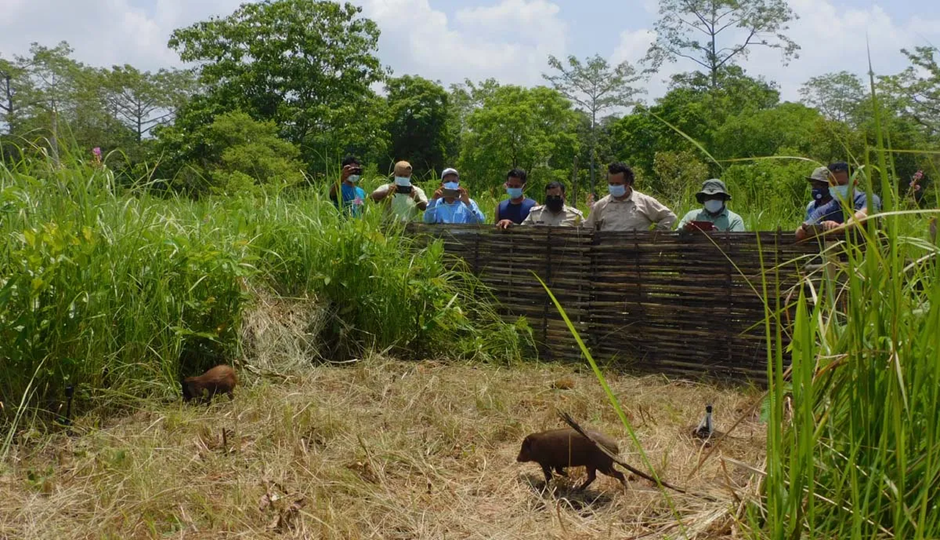- Courses
- GS Full Course 1 Year
- GS Full Course 2 Year
- GS Full Course 3 Year
- GS Full Course Till Selection
- Answer Alpha: Mains 2025 Mentorship
- MEP (Mains Enrichment Programme) Data, Facts
- Essay Target – 150+ Marks
- Online Program
- GS Recorded Course
- Polity
- Geography
- Economy
- Ancient, Medieval and Art & Culture AMAC
- Modern India, Post Independence & World History
- Environment
- Governance
- Science & Technology
- International Relations and Internal Security
- Disaster Management
- Ethics
- NCERT Current Affairs
- Indian Society and Social Issue
- NCERT- Science and Technology
- NCERT - Geography
- NCERT - Ancient History
- NCERT- World History
- NCERT Modern History
- CSAT
- 5 LAYERED ARJUNA Mentorship
- Public Administration Optional
- ABOUT US
- OUR TOPPERS
- TEST SERIES
- FREE STUDY MATERIAL
- VIDEOS
- CONTACT US
Nine Captive-Bred Pygmy Hogs Released in Assam National Park
Nine Captive-Bred Pygmy Hogs Released in Assam National Park
08-10-2024

On October 1, 2024, nine captive-bred pygmy hogs were released into Manas National Park, located in western Assam. This marks the 5th reintroduction exercise by the Pygmy Hog Conservation Programme (PHCP) since 2020.
Key Details:
- Species Information: The pygmy hog (Porcula salvania) is recognized as the world’s smallest and rarest wild pig, currently facing a significant risk of extinction.
- Release Event: The release event was attended by Principal Chief Conservator of Forest and Head of the Forest Force in Assam, who commended the effort to stabilize the pygmy hog population in the national park.
Conservation Efforts
- Previous Releases: A total of 27 pygmy hogs have been released at the Kanchanbari grassland within the national park since the program's inception. A recent camera trap study indicated successful breeding in the area, with a notable first-time capture of a pregnant female hog in the wild.
- Collaborating Organizations: The conservation initiative involves multiple stakeholders, including:
- Assam Forest Department
- Durrell Wildlife Conservation Trust (U.K.)
- International Union for Conservation of Nature (IUCN) Species Survival Commission's Wild Pig Specialist Group
- Union Environment Ministry
- Ecosystems-India
- Aaranyak (Assam-based biodiversity conservation group)
Background of the Pygmy Hog Conservation Programme (PHCP)
- Inception: The PHCP commenced in 1996 with four individuals captured from the Bansbari Range of Manas National Park. The first successful release into the wild occurred in 2008.
- Success Metrics: As of now, the program has successfully bred and reintroduced 179 pygmy hogs in Assam's protected areas.
Habitat and Characteristics of the Pygmy Hog
- Habitat Preference: Pygmy hogs thrive in undisturbed tall grasslands characterized by riverine communities with dense grass, herbs, shrubs, and young trees.
- Ecological Role: As an indicator species, their presence reflects the health of their primary habitat, highlighting the importance of tall, wet grasslands.
Conservation Status
- IUCN Classification: Critically Endangered
- Legal Protection: Listed under Schedule I of the Wildlife Protection Act, 1972.
About Manas National Park
- Location: Situated in Assam, it is contiguous with Bhutan's Royal Manas National Park.
- Designations: Recognized as a UNESCO Natural World Heritage site, Project Tiger reserve, elephant reserve, and biosphere reserve.
- Flora and Fauna: Home to some of the largest remaining grassland habitats in sub-Himalayan ecosystems, it houses rare wildlife, including the Assam roofed turtle, hispid hare, golden langur, and pygmy hog.
About Captive Breeding
- Captive breeding involves capturing wild species, breeding them in controlled facilities, and raising them under expert care.
- It is a recognized conservation tool aimed at preventing extinction and promoting species recovery.
Conclusion
The successful release of pygmy hogs into Manas National Park demonstrates ongoing efforts to conserve one of the world's rarest species. Through collaboration among various stakeholders and continued focus on habitat restoration, the Pygmy Hog Conservation Programme aims to stabilize and grow the population of this critically endangered species.
Must Check: Best IAS Coaching In Delhi
UPSC Prelims Result 2024 Out: Expected Cut Off & Other Details, UPSC Prelims 2024 Answer with Explanation, Daily Prelims Quiz, Daily Current Affairs, MONTHLY CURRENT AFFAIRS TOTAL (CAT) MAGAZINE, Best IAS Coaching Institute in Karol Bagh, Best IAS Coaching Institute in Delhi, Daily Mains Question Answer Practice, ENSURE IAS UPSC Toppers, UPSC Toppers Marksheet, Previous Year Interview Questions, UPSC Syllabus




